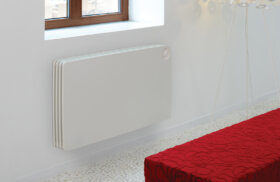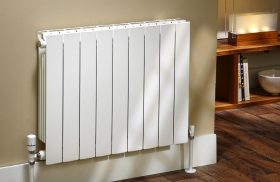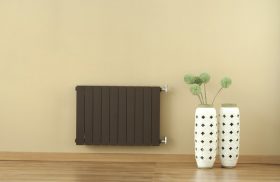If you notice that some of your radiators are not heating up evenly, or there is a gurgling sound coming from your radiator or banging pipes, it often means that air has become trapped in the system. This air needs to be released, a job that is commonly referred to as bleeding.
Bleeding a radiator involves letting the air out to help heat your home more effectively and reduce your energy bills. It requires minimal equipment and isn’t difficult to do!
Here we discuss how to bleed a radiator in eight easy steps.
Why bleeding your radiators is important
Bleeding your radiator helps to get rid of air pockets that stop hot water from circulating around your central heat system efficiently. By letting this air out, your home will heat up more efficiently and cost you less money. If you do not bleed your radiator at least once a year, air can become trapped within your radiators, contributing to cold spots, gurgling noises and an inefficient heating system.
When to bleed radiators?
Ideally, bleeding your radiators should be done before you start heating your house in the winter months. This will ensure that your home remains warm and comfortable during the upcoming cold months of the year.
There are certain signs that indicate trapped air and the need for you to bleed your radiators:
- Reduced heat output – the trapped air prevents the hot water from circulating properly, which can reduce the heat output of the radiator.
- Cold spots – the air pockets can cause cold spots to form in the radiator leading to some rooms being colder than others.
- Gurgling noises – the air pockets can make gurgling noises as the hot water tries to circulate around them.
- Radiators that are warm at the bottom but cool at the top – this is a common sign of trapped air that is preventing hot water from circulating and heating.
What tools do you need to bleed a radiator?
Bleeding a radiator is quite simple and does not require a whole lot of specialist equipment. All you need is a few handy things:
- A radiator bleed key or screwdriver
- Bucket or container to catch any water
- A cloth or towel to clean up any spills
- Safety gloves to protect yourself against any scalding hot water
How to bleed a radiator: A Step-by-Step Guide
- Identify which radiators need bleeding: If the central heating system is not running, switch it on to build up pressure and test the radiators. Take care not to burn yourself when touching hot radiators, but feel each one to identify where air has become trapped. A radiator is noticeably cooler towards the top when this happens. When you discover where the air is trapped, prepare to start bleeding the affected radiators (get an old towel ready!).
- Turn off the heating system: It’s important to turn the heating off again and all the radiators to cool. This is to ensure that the hot water in the radiators doesn’t burn you once you start the bleeding process. Bleeding a radiator with the heating on can lead to hot water spraying out, potentially causing burns or scalds. When the heating system is on, the water inside the radiators is hot and under pressure. Bleeding a radiator releases this pressure, causing hot water and steam to escape. If you attempt to bleed a radiator with the heating on, you risk getting scalded by the hot water or steam. It’s essential to turn off the heating system and allow the radiators to cool down before attempting to bleed them.
- Locate the radiator bleed valve: Now it’s time to locate the bleed valve on the radiator. It’s typically found at the top or side of your radiator and is a small metal square or screw found inside the surrounding nut.
- Prepare to bleed: Position your container beneath the bleed valve to catch any excess water or drips as well as to protect your flooring from any discoloured water. You can also place a towel or cloth near your radiator to protect surrounding surfaces.
- Open the bleed valve: Insert the radiator key or screwdriver into the bleed valve and slowly turn it anticlockwise, listening for the release of air. Hold your cloth next to the valve and under the drain hole to catch any drips.
- Release trapped air: Release the air trapped inside by keeping the radiator valve open until water starts to flow consistently without air bubbles. As the air escapes you will hear a hissing noise.
- Close the bleed valve: Once the hissing sound and air stops and water starts to leak out, you will know that the trapped air has been released. You can now close the valve carefully, and bleed your other radiators following the same steps.
- Check boiler pressure and pressurised (if necessary): If you have a pressurised central heating system, your pressure gauge may have dropped after bleeding your radiators. Check the pressure gauge on your boiler to see if you need to increase the pressure level. This should be sitting at between 1.5 to 2bar when cold. After treating all the radiators that needed bleeding and checking the pressure, turn the heating back on. When they have warmed up there should be no more cool spots on any of your radiators. If all seems well, you have successfully bled your radiator.
How to Bleed a Radiator Without a Key
Bleeding a radiator without a key can be done using a flat-blade screwdriver or a pair of pliers. Here’s a step-by-step guide:
- Turn Off the Heating: Ensure the central heating system is turned off to avoid any accidents or burns.
- Identify the Bleed Valve: Locate the bleed valve at the top of the radiator. It’s typically a small square or hexagonal nut located on one side.
- Prepare a Cloth or Towel: Place a cloth or towel beneath the radiator valve to catch any water that may drip out.
- Use the Screwdriver or Pliers: Insert the flat-blade screwdriver or the tip of the pliers into the groove of the bleed valve.
- Turn Counter-Clockwise: Gently turn the screwdriver or pliers counter-clockwise to open the bleed valve. You’ll hear a hissing sound as air escapes.
- Wait for Water: Keep the valve open until water starts to trickle out steadily. Once water begins to flow without any air bubbles, quickly close the valve by turning it clockwise.
- Check Pressure: Once you’ve bled all the radiators, check the pressure gauge on your boiler to ensure it’s at the correct level. If needed, add more water to the system.
- Test the Radiator: Turn the central heating system back on and test the radiator to ensure it’s heating evenly.
Remember to take caution while handling hot water and heating systems. If you’re unsure or uncomfortable with the process, it’s best to contact a professional plumber or heating engineer.
Troubleshooting common issues
There may be some common issues that you may encounter during the bleeding process:
- Stubborn bleed valves – if the bleed valve is stubborn and doesn’t turn easily, you can try using a pair of pliers to grip the bleed key. You can also try soaking the bleed valve in hot water for a few minutes to loosen it up.
- Radiators that continue to have cold spots – if your radiator still has cold spots after you have bled it, it could be a sign of a more serious problem, such as a blocked radiator or a faulty valve. In this case, it is best to call a qualified plumber to inspect the radiator.
Contact us for advice on bleeding radiators
It’s good practice to bleed your radiators once a year so you have peace of mind that your heating system is working efficiently. The perfect time to do this is around autumn time, just before winter so you can ensure your heating system is working efficiently. Plus, you can avoid unnecessary heating costs!





